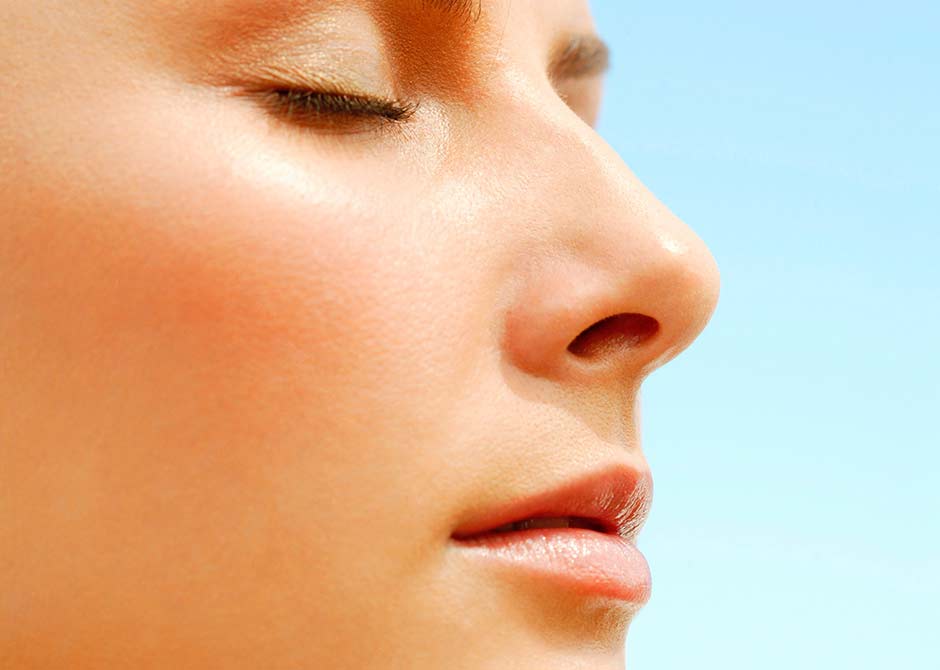What is rhinoplasty?
Rhinoplasty, often called a nose job, is a type of plastic surgery done to change the shape, size, position or form of your nose. Rhinoplasty is sometimes performed to correct structural defects or functional problems. If you’re unhappy or self-conscious about the appearance of your nose, plastic surgery could be an option for you.
Nose surgery can correct these and other problems:
- A nose that is smaller, thinner, wider or larger than desired
- Bumps or depressions on the bridge of your nose
- An enlarged nasal tip or a tip that is sagging, upturned or hooked
- Large, wide or upturned nostrils
- Deviated septum (defect in wall separating nasal cavities)
- Other deformities or damage, including conditions related to injury or disease
You’ll find some of America’s best rhinoplasty surgeons at The Ohio State University Wexner Medical Center in Columbus. Ohio State’s board certified plastic surgeons have advanced skills and expertise in rhinoplasty and related cosmetic surgery and reconstructive surgery procedures that are sometimes combined with nose surgery.
Plastic surgeons at Ohio State may perform rhinoplasty in addition to cosmetic procedures such as eyelid surgery, facelift or nonsurgical facial and skin rejuvenation. Ohio State’s team includes reconstructive surgery specialists who can repair minor or severe nose damage due to injury, or diseases such as cancer.
What to expect if you have nose surgery
Surgery preparation and procedure steps vary, depending on the type of surgery and treatment goals. Your plastic surgeon will discuss details in a pre-operative visit. You may have lab work or other testing. You may need to make certain dietary, medication and other adjustments.
During rhinoplasty surgery
You’ll have medication for your comfort during the rhinoplasty procedure. Your doctor will recommend the best option, which may be intravenous (IV) sedation or general anesthesia. Choices vary, depending on how complex your procedure is and whether you’re having more than one procedure.
Your doctor will start by making an incision in your nose. There are different types of incision approaches. These include:
- Closed procedure – The surgeon makes hidden incisions inside the nose
- Open procedure – The surgeon makes an incision across the columella, the thin strip of skin and tissue between the nostrils
- Additional incisions – The doctor may make incisions within the natural creases of the nostrils to change their size or shape
During the procedure, your surgeon may remove bone or cartilage to make your nose smaller or add cartilage grafts to reshape the nose. Typically, cartilage is taken from your septum for grafting. In some instances, the doctor may take cartilage from your ear or, less commonly, from a rib.
If needed, the surgeon will straighten and realign the septum and repair any other tissues that may interfere with normal airflow. The doctor may treat nostrils to adjust their size or shape. Once the surgery is complete, your doctor will carefully reposition skin tissues and close incisions.
After rhinoplasty surgery
You’ll be in a recovery room for medical monitoring as the anesthesia wears off. You may feel some discomfort and congestion due to swelling and gauze or splints in your nose. You may have a drainage pad taped beneath your nose to absorb fluid as wounds heal.
If your condition is stable, you should be able to go home the same day. The doctor will remove any stitches or splints during a follow-up office visit, typically within a week of your surgery.
Your doctor will give you instructions about how to care for your wounds, including how often to change the dressings in your nose. You may have to rest in bed with your head raised slightly above chest-level to help the wounds drain.
The surgeon may prescribe medication, including something to help prevent infection. Your doctor will also advise you about these and other precautions to protect wounds and promote safe and successful results:
- Avoid strenuous activity as instructed
- Take baths instead of showers
- Don’t blow your nose
- Eat a nutritional diet, with limited sodium and plenty of fiber
- Don’t rest your eyeglasses or sunglasses on the bridge of your nose. Ask your doctor about alternative positioning options
- Protect your nose from the sun and use sunscreen
- Try to avoid exaggerated facial expressions that may put pressure on your wounds
- Brush teeth carefully, limiting upper lip movement
- Choose clothes with front-closure so that you don’t have to pull clothing over your head

Rhinoplasty results
You can expect long-lasting results after rhinoplasty surgery. It can take up to a year for your nose to fully take shape as tissues settle. Some changes are normal over time, due to aging and gravity. Healthy lifestyle habits, including sun protection, can protect your skin and help your results last longer.Rhinoplasty risks
Any surgery has some risks such as bleeding, infection and reaction to anesthesia. Your surgeon will discuss possible risks, such as:
- An unbalanced or uneven nose
- Numbness in or around the area treated
- Pain, redness and swelling
- Poor wound healing
- Excess scarring
- Results requiring revision surgery
- Septal perforation (hole in septum)
- Trouble breathing through your nose
Why choose Ohio State for rhinoplasty?
If you’re considering rhinoplasty, it’s essential to choose a skilled and experienced plastic surgeon. At the Ohio State Wexner Medical Center, you’ll find board certified plastic surgeons with expertise in a wide range of innovative rhinoplasty techniques.
Ohio State is an internationally recognized teaching and research hospital. Our physician leaders train the next generation of plastic surgeons. Ohio State plastic surgeons also conduct pioneering research to develop new advances in cosmetic and reconstructive plastic surgery.
At Ohio State, you’ll have access to:
- Board certified plastic surgeons with high-level skills in plastic surgery with multidisciplinary expertise in related areas of medicine, such as microsurgery and reconstructive surgery
- Comprehensive care from seasoned surgeons who prioritize your safety
- Sophisticated techniques that help make your recovery easier and quicker
